Greetings friends and myriad enthusiasts of 'old time' traditional special photographic effects, mattes, miniatures, trick shots and all such 'lost' art forms of days gone by. It is time for yet another journey down that ever fascinating path of wonderful motion picture magic, that we all love so much.
Today, I've assembled a very broad cross section of films, from across the cinematic spectrum - from science fiction, western, swashbuckler, jungle adventure and epic desert romance genres - all here in the one packed blog post. As usual, I've included a few worthy titles that few - if any - may have heard of, let alone seen. Any younger readers probably haven't heard of any of the seven titles profiled here in depth. There is nothing as thrilling for NZ Pete than discovering some heretofore 'lost' or forgotten flick that not only is a revealing trick shot show, but also a highly enjoyable film in itself to top it off, and that reward came with at least one of the movies here today.
-------------------------------------------------------------------------------------------------------------------------
.JPG)
Before we dive deep into the roster of effects films I've lined up, I must once again, bring to the attention of all readers out there the ever expanding You Tube channel, 'Albert Whitlock's Matte Department & Illusion Arts' in which my friend Thomas Higginson has spent endless hours/days/weeks with his eye lids propped open with matchsticks, and endless cups of strong coffee, tirelessly putting together a series of tremendous behind the scenes matte shot reels from a selection of films. Films such as GENESIS II; BOUND FOR GLORY; THE TWILIGHT ZONE tv series; SHIP OF FOOLS and BUCK ROGERS have thus far been highlighted in great detail, with the BUCK doco being my particular favourite thus far. I'm sure I speak for all of us who love this medium of magic that we are extremely grateful to Tom for taking on this project and preserving and presenting these valuable pieces of celluloid photographic effects history and making so much available to the public at large, rather than archived away in some Lost Ark styled warehouse, and never seeing the light of day again.

As of this writing, several more are in the works, or nearing completion such as the Bond picture DIAMONDS ARE FOREVER
(due out any day now); the unrealised 80's remake of THE LOST WORLD; sci-fi classic COLOSSUS-THE FORBIN PROJECT; disaster epic EARTHQUAKE and many more. Absolutely essential viewing
(and re-viewing) that any fan of Al Whitlock and Syd Dutton and the warehouse full of remarkable shots these guys turned out (in the several hundred!). Find it
here!!!
Also well worth a look on the same site is a touching memorial video and photo tribute to the late Bill Taylor, with some wonderful anecdotes and most touching and occasionally quite funny tributes from some of those who knew Bill. I most strongly recommend it.
So, as per usual, it is time to board the interstellar ship for our journey through that galaxy of wonder that we recognise and appreciate as the traditional matte painted trick shot...and a healthy bounty of miniatures as well just to balance things out nicely. Oh, and do forgive me for slipping off topic on the odd occasion - going on about certain actors or directors or things seemingly unrelated - as I have a habit of doing.
Enjoy the ride
Peter
-------------------------------------------------------------------------------------------------------------------
Now.... on with the show
***This post, and all 179 previous blog posts known as 'Matte Shot', were originally created by Peter Cook for nzpetesmatteshot, with all content, layout and text originally published at http://nzpetesmatteshot.blogspot.com/ -------------------------------------------------------------------------------------------------------------------
 |
| Curiously, HEARTBEEPS (1981) was itself a planned 'making of' YouTube project but for various reasons the original Whitlock 35mm fx reels from Bill Taylor's collection weren't able to be digitized, despite a plan to do so due to lack of funding, for what is a very expensive exercise. |
 |
| I didn't at all care for the film back in the 1980's, though, as I enter my twilight years I find myself mellowing somewhat and can now appreciate it far more as a cute, sweet natured fable, though certainly flawed, it definitely has it's heart in the right place. I'll talk more about the film's director, Allan Arkush shortly, but it's worth noting that Allan himself stated that he hadn't really been a special effects fan as such, and found this aspect in HEARTBEEPS - what with make up fx, mechanical devices and of course mattes - somewhat intimidating to say the least. Allan confessed to an interviewer that looking back, he never felt he used 'special effects' in this film as well as he should have. Unlike all of us reading this post, Arkush confessed that he never ever 'dissected' effects movies! |
 |
| Basically, a gentle sci-fi love story set in the very near future, HEARTBEEPS sees a pair of robots fall in love and abscond from the vast android factory. A well cast Andy Kaufman and Bernadette Peters were the besotted mechanised pair, under significant and beautifully designed Stan Winston make up appliances. |
 |
| Albert Whitlock oversaw the many mattes and photographic effects shots, with uncredited assistant, Syd Dutton providing a number of mattes. Interestingly, in addition to fx cinematographers Bill Taylor and Dennis Glouner being screen credited, assistant grip Henry Schoessler got his name up there, as did Al's son Mark as general assistant. |
.jpg) |
| Al Whitlock with trusty tied down and rock steady matte camera. |
 |
| A snapshot of Whitlock and his crew on location for the film MACARTHUR, made some four years previous. |
 |
| Universal Studio's resident masters of illusion, Albert Whitlock, Syd Dutton and Bill Taylor. Note: The top left pic appears to show the Mitchell matte camera mounted on a Nodal Point camera head. |
 |
| The opening extremely wide pan shot - or at least a portion of it - with matte assistant Mark Whitlock in costume and added into an already very complex composite as a blue screen element. Mark would himself become a talented matte artist a few years after and painted on a number of films and tv shows including at least one shot for this film. |
 |
| The very broad pan across a large painted setting and robot factory. A highly complicated multiple composite shot integrating live action elements, paintings, miniature props, animation and cel overlays, to brilliant effect. |
 |
| Partial before and after... I spoke with the late (and very generous) Mr Bill Taylor some time ago about this shot which has intrigued me. As was Bill's typical way, he went out of his way to describe and illustrate the process to me: "The HEARTBEEPS shot is one of the few made with our 'Super Lens', originally created for DUNE but never used on it. The Super Lens let us put a 2:1 squeeze on the long dimension [width] of the VistaVision frame, giving a 3:1 aspect ratio, which gave us more real estate for optical pans. The optical quality of the lens was okay at small apertures; it was a prototype and could have used another iteration in the design. The spinning whirly-gig was the only miniature element. The heatwaves in the final shot on right were built into the original negative shot - though too broad I think. The foreground chap who goes right over the painting is Mark Whitlock, shot on our blue screen stage. The Super Lens was also used for the opening matte shot of THE BEST LITTLE WHOREHOUSE IN TEXAS". |
 |
| The latter part of the wide pan across the fictional setting. |
.JPG) |
| Al's phenomenal painting. Syd told me that the work was split between the pair of them, with Al handling all of the exterior/outdoors scenes and Syd painting all of the various factory interiors. |
 |
| A splendid close look at Whitlock's magnificent piece, with all of the classic attributes Al was so respected for, such as his evocative feeling of how light plays upon objects, especially with a three-quarter backlight and long shadows. Al's sense of depth and expanse of distance through quite simple brushwork with his receding light. A master of the art form. |
.jpg) |
| Al with his massive painting, which I believe was auctioned off a while back and is now proudly in the ownership of one of the effects industry's VFX supervisors. You'd need a vast wall space to accommodate this beauty! Note: the blacked out area at right was for addition of a large miniature prop and a full size painted wall facade, which will all blend in perfectly in Bill Taylor's final composite. Bravo! |
.jpg) |
| Nicely detailed and mobile miniature satellite dish, built by David Merritt, and roughly painted facade backing behind Whitlock which will blend invisibly with the separately rendered matte painting in the very complex finished shot. |
.jpg) |
| Three integral members of the Universal matte crew; grip and highly resourseful modeller, Lynn Ledgerwood. Long time Universal matte camera operator, Mike Moramarco, and optical and matte cinematographer Dennis Glouner - who happened to be the nephew of old time Columbia effects cameraman Donald Glouner, with the Glouner family name going way back to old time Hollywood. |
 |
| Close up detail. |
 |
| The first of several matte painted interiors rendered by Syd Dutton. Syd told me he didn't at all mind being lumped with these chores: "I was quite happy to do the more tedious work". |
 |
| Another quick matte with actors Randy Quaid and Kenneth McMillan added in via travelling matte. |
.jpg) |
| Syd's original matte art for above scene. See below for breakdown. |
 |
| The basic set and masked off half frame prior to Syd's painting being added. |
 |
| The final shot with matte art and live action, shown here before the introduction of blue screened in foreground live action which in the final cut obscures much of Syd's painting. |
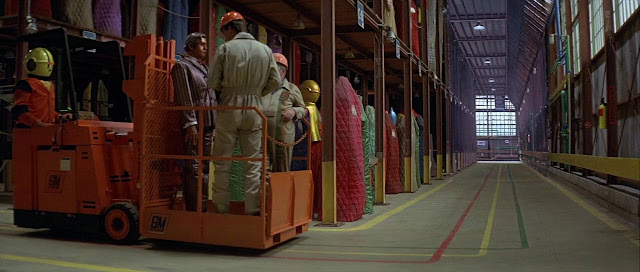 |
| Another from the succession of Syd's many mattes, with the distant factory facility being painted in. |
 |
| A wonderfully constructed matted set extension done as a cost saver to the production, though the budget was some $12 million. All of the windows, scenery, flooring and distant racking was Syd's. |
 |
| A split shot here with half real set on left and the other side all painted on glass. Lots of perspective drawing needed here. |
 |
| A key matte illusion in HEARTBEEPS was the beautiful sunset sequence as viewed by our two robots as they ponder what lies beyond the confines of this enormous mechanical workshop. The effect was far more involved that might seem at first glance, with this important matte painting appearing several times in one extended sequence. |
 |
| Al's multi element sunset painting, combined with a real interactively lit foreground tree, comped as a blue screen shot with the stage set and actors. |
 |
| Whitlock's beautiful original matte art, which I'm thrilled to say I own and admire each time I enter or exit our bedroom, with it gracing the wall outside the door. |
 |
| Closer detail reveals Albert's love of the Hudson River School of 19th Century painters such as Thomas Cole, Frederic Church and Albert Bierstadt. Al was a huge admirer of these painters and that was reflected in many of his own personal 'fine' paintings that are still in circulation and private ownership. Interestingly, when asked in an interview way back in the early 70's about his own non-matte painting interests,and how much he turns out, Al responded: "Well, not much, as by 4pm here at the studio, I find that I'm all painted out". |
 |
| More detail from Al's sunset matte, with magnificent violet and cobalt hues receding into the distance. Al was an absolute master of light and it's effect, which was why so much of his work was undetectable. |
 |
| Subtle, yet quite labour intensive work as Al discussed in 1981 while finishing the matte work on HEARTBEEPS: "I think it's generally considered that film only has a perception of 4 f-stops. A camera has a constant iris, unless you are changing that iris while shooting, there is a certain fixed f-stop that limits the film as we know it today, to about 4 f-stops. The eye of course constantly has the iris going in and out when looking at brighter or darker phenomena, so film has to have a limitation. The paintings have to have that same limitation. Reaching into a very shady landscape, regardless to what's on the sky, invariably it burns out that sky, so that's the limitation of film". |
 |
| Albert continued: "Our setting sun was done with a light. Then we'll fade the painting out and fade some overlays in, which I've already done, of detail, so that the light appears to be gradually going off of the trees. For the wider master shot a real tree was blue screened into the left corner, with sunlight playing on the gently moving foliage. The clouds in the sky will be moving using soft splits, so the movement playing over the painting will lend a greater sense of realism - it'll be more persuasive you know. The sky moves almost imperceptibly, but if it didn't, the whole thing might look static". |
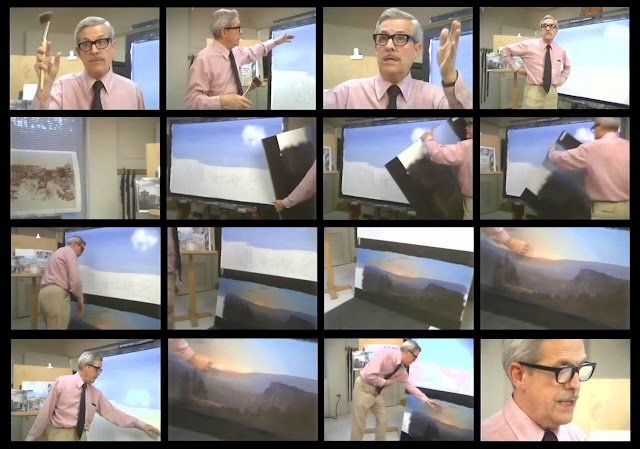 |
| Albert demonstrates the manner in which acetate cel overlays will sell the finished shot: "The overlay of detail on trees, fading just slightly, before the painting itself fades - a very small matter, but enough to add up, all in all, to a much more interesting scene. They couldn't get the shot for real, so we go back our 4 f-stops theory. I'm cheating here. The sky would burn out if you saw that much lower detail in the landscape, but since it's a painting I can cheat it a bit you know, and bring the tones more together. The sky won't burn out, or the lower portion will not go into a total silhouette, which would happen if you were exposing expressly for the sky". |
 |
| Albert's original on NZ Pete's wall :) |
 |
| The droids start to question their place in their man-made confines and wonder what lies beyond... |
 |
| Syd Dutton interior set extensions with a thunderstorm outside. Very nice interactive shadows of heavy rain seen within the painted areas, presumably done as animated cel overlays. |
.jpg) |
| Breakdown showing limited extent of set and invisible additions painted in. |
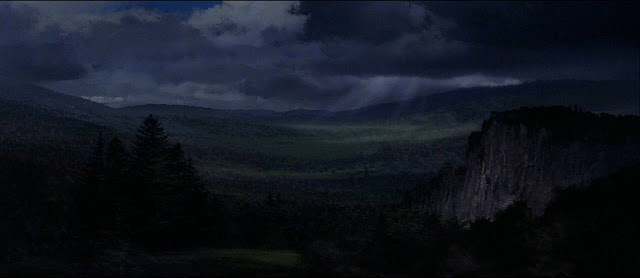 |
| Frame #1: The storm subsides and the first rays of daylight break through the clouds. Another of Whitlock's extensive mattes, with soft split screened cloud movement, painted cel overlay animation for sunlight and interactive light hitting the valley floor. |
 |
| Frame #2 |
 |
| Frame #3 |
 |
| Frame #4 |
 |
| Frame #5 |
 |
| The movie was directed by Allan Arkush - himself a most fascinating fellow. Allan began his film career - along with friend Joe Dante - as trailer cutter for Roger Corman's New World Pictures in the 70's. Now, as a firm fan of 'B' pictures and low grade exploitation flicks myself I'm quite familiar with most all of those cheesy flicks, and even more so with the incredibly 'in-your-face' coming attractions trailers for them that Allan and Joe concocted - each one a mini masterpiece of lurid showmanship! Breasts, bums; the same explosion that appeared in a ton of trailers but never in any of those films; shotgun blasting vigilantes, airplane decapitations, bikers and shackled Filipino chain gang gals...all packed into 3 amazing minutes for titles like T.N.T JACKSON; CAGED HEAT; SAVAGE SISTERS; NAKED FIST and the unforgettably 'Z' grade BURY ME AN ANGEL: ("a howling hellcat humping a hot steel hog, twisted by torment, a sadistic she-devil, leading a pair of perverts on a roaring rampage of revenge"). Classics none of my blog readers would ever have heard of! Special mention here for the voice actor of the CrimeBuster robot in HEARTBEEPS who was voiced by former New World trailer narrator, the great Ron Gans - the all time king of bass-baritone trailer voice-over artistes, bar none!! Both Allan and Joe impressed the hell out of Corman so much that he gave them their own feature to direct - so long as it cost $10 bucks and came in on time. They made the wonderful HOLLYWOOD BOULEVARD (1976) for pocket change by raiding the New World film vaults and 're-purposing' a ton of sequences from previous Corman films - all shows they knew like the back of their hands from their trailer work - and cut into an entirely 'new' full length plot(!!) It's a hoot, especially if you know those numerous 'stolen' sequences like I do. This is probably far more info than any reader cares to know, but I did say that I tend to drift off topic, didn't I? |
 |
| Subsequent shot is this glorious view of the whole valley in bright sunlight, complete with drifting clouds. |
 |
| Close up |
 |
| Although we only get to see the daylight view through the factory window, it's still a wonderful shot. Note the addition of rainbows painted onto a separate glass and presumably superimposed after the filming of the cloud soft splits as a separate run through Bill's matte camera. The foreground set was then combined as a blue screen travelling matte to the paintings. |
 |
| Albert sets a matte in camera with the assistance of Michael Moramarco - a long time member of Universal's matte department stretching back to the Ross Hoffman era and very early Whitlock tenure. |
 |
| A wonderful vista of the robot factory off in the distance, as painted by Albert, with the matte extending as far down as the lower tree line. Crystal clear image fidelity as Al was the world's biggest advocate of original negative latent image matte shots, which is why they all look so good. Beautiful sense of backlight - a phenomena I've always loved about his work, which was Al's forte, and an asset I tend to feel he likely picked up from the great Peter Ellenshaw while at Disney. |
 |
| Among the oddball characters - both human and 'bucket-of-bolts' in the flick, was the wonderful concept of having a stand-up comic android - as one does, with Catskill (top left) being just such a mechanical jokester. Catskill's non-stop one liners were written by real life Borsch Belt comic Henny Youngman, and voiced here by Jack Carter - complete with auto 'drum roll & cymbal ding' for each witticism! |
.jpg) |
| Now, as a lifelong movie buff, with interests in ALL aspects of the game, I've always had a great respect for the acting profession, and none more so than what would be termed 'character actors'. So many great films over the years are memorable not just for the lead players but more so for the small part character actors (I could name a hundred such!). HEARTBEEPS hit bullseye with several small roles played by tried and true great character actors. Top left: Randy (Midnight Express) Quaid with Kenneth (The Taking of Pelham 123) McMillan. Top right: the legendary one of a kind Dick (The Terminator) Miller. Bottom left: the always memorable Mary (Death Race 2000) Woronov. Bottom right: the highly talented director-actor-writer Paul (Eating Raoul) Bartel. Also in the flick are reliable old pro's Kathleen (Blues Brothers) Freeman and Richard B.(The Anderson Tapes) Schull in small walk ons. |
 |
| A matte that many missed, of the spare parts wrecking yard of old robots. Note: rotoscope work evident as the two robots heads pass above the matte demarcation line, with Kaufman's head being slightly translucent for several frames. |
.jpg) |
Albert's painting for the robot junkyard scene. The very contrasty trees may have been hold outs for separately painted tree texture, though why go to the trouble, I don't know.
|
.JPG) |
| A curiosity here. This is a mystery glass painting rendered by Syd Dutton, which all indications suggest was made for a sequence that landed on the cutting room floor. Syd did however recall painting something similar for a tv commercial which featured a robot rebellion or some such. |
 |
| Now, this late in the narrative shot proved most interesting, and was a trick shot I'd never noticed until this recent re-evaluation on BluRay. On a few repeat rewinds I felt compelled to question the view as a likely matte composite. I asked Syd, who was fairly sure it was a regular production shot. We begged to differ, so we asked Tom Higginson if there was any archived evidence one way or the other. See below... |
.jpg) |
| ...and here it is. Mark Whitlock painted this apparently quick, though totally effective rendering on glass which slotted in nicely with the location footage above. Note, the characters visible far off atop the hillside in the finished scene must have been doubled in as a bi-pack element, or may have been a cel overlay animation gag? Syd, my friend... you owe Pete a beer ;) |
 |
| Special make up designer Stan Winston (right) with associate Zoltan Elak. |
 |
| Dreadful alternative ad-campaign by Universal to try to sell an admittedly difficult release. Oh, and that 'Crimebuster' there is the one voiced by the great Ron Gans - trash drive-in trailer voice over artiste bar none! As an aside, Ron did some great parody trailers for John Landis' KENTUCKY FRIED MOVIE, with the hilariously unforgettable 'Catholic High School Girls In Trouble' and the pseudo Hebrew-blaxploitation spoof 'Cleopatra Schwarz'.... though, as usual, I digress. |
-------------------------------------------------------------------------------------------------------------------------
 |
| Time for a distinct change of pace here. CAPTAIN HORATIO HORNBLOWER (1951) was an excellent, big budget period action adventure packed with special effects, with a number of technicians credited, and at least one important creative individual omitted completely! |
 |
| Although a Warner Bros release, it was in fact entirely filmed in the United Kingdom, though with a mix of British and American staffers. |
 |
| As grand a title opener as one could expect, though the four SFX men credited all deserved kudos, a name missed out here really was an unfortunate omission, as we shall discover... |
.JPG) |
| The effects team was split between Brit experts and experienced career Americans. Shown here are the two English mechanical & miniature effects supervisors, the legendary Cliff Richardson (left) and George Blackwell (right). Cliff - pictured here in 1951 finessing a trigger gag to one of the miniature cannons for CAPT HORNBLOWER - was considered the grandfather of physical and model effects in the British industry, having entered it around 1923. He would spend a great deal of his career working at Ealing Studios, among others, and became one of the most respected technicians in the business. Cliff's son John followed in his footsteps and himself became one of Britain's most in demand experts. George Blackwell was another very well known model specialist in the UK industry, with decades of employment at Rank-Pinewood and other studios where he displayed a special ability with hanging miniatures and aircraft. George's work on the still brilliant WWII true story DAMBUSTERS saw him receive an Oscar nomination. The pic here shows George with one of his miniatures for the film YANGZE INCIDENT. |
 |
| Another important contributor to the film, and an uncredited one at that, was the remarkably talented Peter Ellenshaw. This film was one of several Peter painted for between his years with mentor Poppa Day at Denham and his subsequent profitable tenure with Disney on the UK productions and beyond. |
 |
| The great Peter Ellenshaw at work in various periods of his long career as premier matte artist. The bottom left pic is in the matte room on THE BLACK HOLE while the bottom right photo is a mystery to me, as it is to Peter's son Harrison. It's stamped with the Disney logo so must be one of their shows like IN SEARCH OF THE CASTAWAYS or 20'000 LEAGUES? Though it could even be from CAPTAIN HORATIO HORNBLOWER, though not a Disney film, the foreground glass painted sky over a model tank set up is most interesting. |
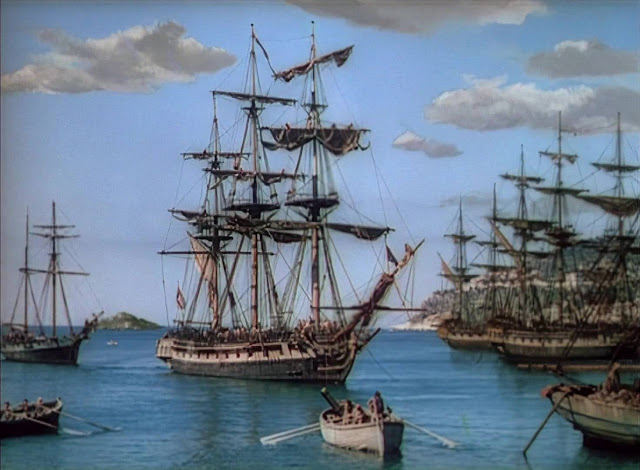 |
| The opening shot is this wonderful Ellenshaw matte painting - with old sailing ships being a specialty of Peter's for a time with his gallery art. |
 |
| Along with Cliff and George, two American effects guys were on board, so to speak. Veteran mechanical effects expert Harry Barndollar had a very long career in trick work, having started off as an artist rendering title paintings for silents as far back as 1918. Harry later found gainful employment in physical effects at Warner Bros and worked on miniatures at Paramount for WHEN WORLDS COLLIDE among others. CAPT. HORNBLOWER was Harry's final film. Also on effects was Arthur Rhoades who, among other films, built the life sized mechanical dinosaur heads for the Irwin Allen extravaganza ANIMAL WORLD. |
 |
| Although the superb sea-going sequences all have the appearance of being shot in actual ocean environs, they were all, most surprisingly, filmed in a large specially constructed tank at Denham Studios outside of London |
 |
| Peter Ellenshaw has painted the set here from just above the doors on upward. |
 |
| A fine example of miniaturisation and mechanics here, with not only a splendid model sail ship in tow, but model rowboats complete with automated puppets working the oars. Top notch. |
 |
| More splendid Ellenshaw matte art here - all highly atmospheric. A later scene uses the same basic painting, though with an altered sky and different ship on the horizon (see below...) |
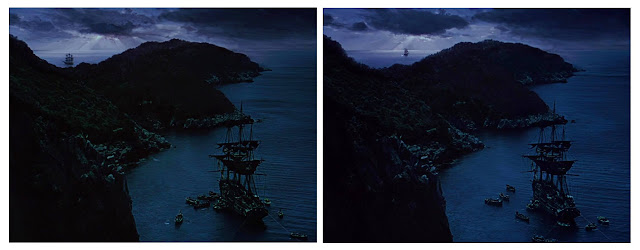 |
| Same painting, re-jigged for two different scenes. |
 |
| I'm fairly sure this is a miniature with a skillfully matted in lower area with actor clambering on board under the cover of darkness. |
 |
| A follow up shot from same sequence, which while it might be a mock up ship on the stage, I tend to think some matting has been executed here due to ever so slight depth of field focus issues. |
 |
| Reverse view from same scene, which once again I feel is a very well combined split screen of either a miniature or matte art? Very impressive, as are all of HORNBLOWER'S trick shots. |
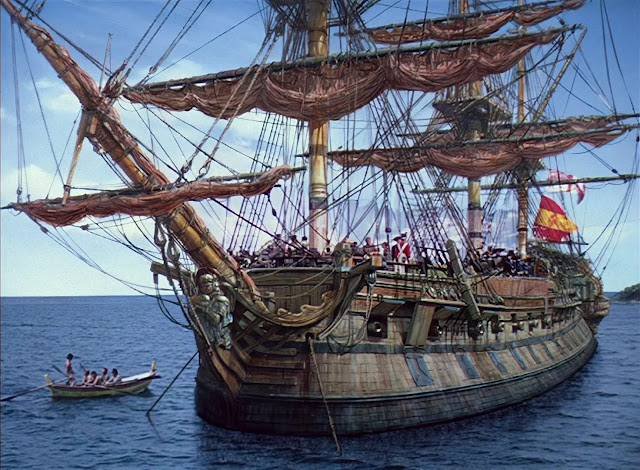 |
| Now here folks is one very bold visual effects shot courtesy of Peter Ellenshaw. A multi-element trick shot comprising actual sea with rowboat, an extensive matte painting of the ship and other details, and a very cleverly combined live action element inserted into Peter's painting comprising of the deck of the ship and the actors - shot on a sound stage. All in all, some courage here in producing this shot. I may be wrong, but I vaguely recall maybe Alan Hume - the esteemed future D.O.P - may have been Peter's matte cameraman here (or Les Ostinelli)? |
 |
| Before and after. |
 |
| Two part comp, with Denham tank foreground, and what I'm sure is Ellenshaw's painted distant ship and sky matted in. |
 |
| Presumably miniature just before the shootin' starts. |
 |
| Tank and glass painting again. |
 |
| In author John Brosnan's utterly indispensable book, Movie Magic (an absolute must!), Cliff Richardson described in detail working on the model effects for this film. "When my contract with Alexander Korda expired, I went free-lance. At the time I was about the only free-lance fx man in the business. The first film I worked on was CAPT. HORATIO HORNBLOWER RN in 1951 for Warner Bros. We spent eight months on that. It was made at three different studios - at Teddington, when Teddington was the UK Warner Bros. studio; at EMI, which was then Associated British Pictures, and also at Denham Studios. All the miniatures were shot at Denham. Actually, the place had just folded, Rank had moved out, and we were the only picture shooting in there". |
 |
| Cliff continues: "We spent a couple of months up at what they call 'city square' on the Denham lot shooting all the miniatures in an enormous tank that they built just for the picture. It was a big tank by any standards - some 300 feet long by 200 feet wide and 6 feet deep. The man responsible was Peter Duco, who is quite a well known construction manager. The tank was made of timber, and the floor and interior walls were covered with asphalt". |
 |
| Some of the best marine model work ever done in my opinion. All beautifully staged and shot - and out in daylight which makes all the difference. More recollections from Cliff Richardson: "We had rostrums built all around the sides of the tank, for the many wind machines that were capable of 12'000 horse power. But we would start a shot of our miniature fleet sailing majestically down the tank with the sails billowing beautifully from the wind created by these machines and a slight natural breeze would come from the opposite direction and blow the sails inside out, which ruined our shot". |
 |
| Cannonballs fire from all sides... |
 |
| Cliff Richardson: "It was a bad summer that year with a lot of rain, and our shooting was often delayed. Scenes with model ships, in my opinion, present some of the greatest problems. The density of the water is not proportionate to the scale of the models so we have to put wetting agents into the tank to reduce surface tension". |
 |
| On scale, the models were substantial: "Our model ships in HORNBLOWER were built on quite a large scale - they averaged some thirty feet long and carried forty square feet of sail. We had three men on each ship. Their job was to handle the auxiliary engines - we had to have engines to give the models more speed as we were filming with high speed cameras - and also to fire the guns and tack the sails". |

 |
| Mayhem at sea in the Denham miniatures tank. In his 1974 interview Richardson elaborated: "I always remember at that time we hadn't got around to using squibs - these little explosive charges that we now use for blowing holes in cloth and bullet hits. So, we found the best way to create the effect of a cannonball going through the sails was by using ordinary number 6 detonators. I had steel plates made to go over the top of the effects guys in the hold, but on some days it was very hot weather and I always used to make a point of shouting out 'Are you chaps covered up?', before I fired these things, and they would say 'Yes', whether they were or not. I remember that several of them got hit by fragments of copper from the detonators exploding in the sails. Nothing that serious, but they often had the unit nurse picking pieces of copper out of their backs." |
 |
| The sprawling 18th Century harbour filled with vessels is a Peter Ellenshaw matte shot with more painted than you'd think. |
 |
| Richardson spoke of the Denham tank: "The tank was dismantled after the picture. Most big tanks are built outdoors but there's one big indoor one at Shepperton". Cliff's then very young son John recalled visiting the special effects tank as a kid, with a crew member taking the boy across the miniatures tank in a rowboat to see the sailboat models - which presumably stoked the trick shot blood flowing through his veins. John recalled the huge and noisy system his dad was using to lend realistic waves to the tank work: "He acquired three Mosquito airplanes from the RAF - they had a few they weren't using any more. He chopped their wings off and mounted the remaining aircraft bodies on rigid frames which were firmly attached to the ground. Cliff then employed three RAF mechanics to actually run the engines". |
 |
| More superb miniature work. |
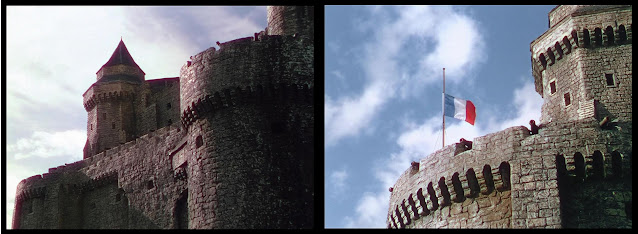 |
| A great miniature is only as good as it's fx cinematographer. |
 |
| Combination shots using model set ups and star Gregory Peck added in via travelling matte, presumably as blue screen, though England was very big on yellow backing sodium composites probably around then, with Rank leading the game. |
 |
| Cannonballs everywhere courtesy of Cliff Richardson's tiny explosive devices and careful timing. |
 |
| Another trick shot as rendered with oil paints on glass by master matte artist Peter Ellenshaw. Almost all of this shot has been fabricated in Peter's matte studio. |
 |
| Carnage, and an insurance nightmare for Lloyds of London. |
 |
| The closing shot is, once again, a complete fabrication - entirely painted, including the man with the telescope - with just the fluttering flag being an actual live element added in later. |
-------------------------------------------------------------------------------------------------------------------------
.jpg) |
| I'm a huge Western movie fan ever since I was a kid, and it's a joy to discover one that I've never heard of, and, is a good show, and, has ample matte work to boot |
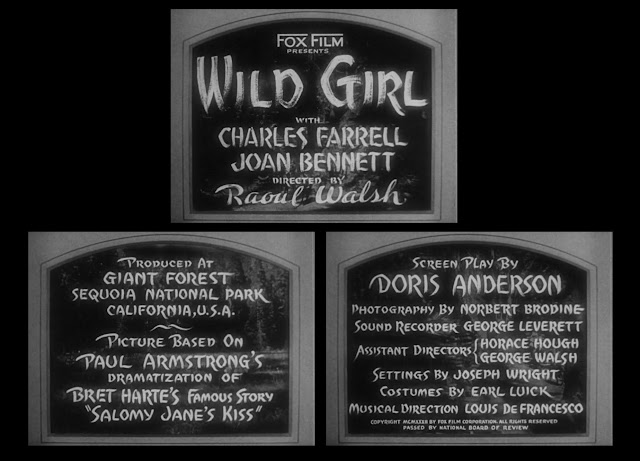 |
| A 'Fox' film - before they became 20th Century Fox - WILD GIRL (1932) was highly promoted for it's 'all on location' production at Great Forest Sequoia National Park, though in truth, a considerable amount of grandeur came about through matte and glass shots. |
 |
| Between takes on WILD GIRL |
 |
| No FX credit, though most likely supervised by either Fred Sersen or Ralph Hammeras - both formative trick shot exponents at Fox, and each immensley talented in all aspects of movie magic, from matte painting and opticals to model photography. The pic in middle is an old snapshot taken on the Fox back lot with Sersen standing up front, as his crew of matte painters work on three massive glass shots. It's quite possible those paintings were made for this film? The fellow at right is long time Fox matte artist Fitch Fulton - the father of famous effects man John P. Fulton. Fitch had painted beautiful mattes for an earlier Fox western, the epic 65mm classic THE BIG TRAIL (1930), so it's highly likely he worked on WILD GIRL as well. |
 |
| Opening shot is a very wide pan, beginning on this view where the entire upper half of the set has been extended as a glass shot. See below... |
 |
| The full pan, done as a series of painted glasses, side by side, and disguised with posts and bits of foreground architecture - an old trick that Sersen's department would excel at in countless films. |
 |
| Again, painted rooftops and redwood forest. |
 |
| The sort of glass shot one would never notice, and must have been quite tricky, with the painted extension covering more of the set than one might expect. Note, the raised hand of 'froggie voiced' character actor Eugene Pallette which vanishes through the painting. See below... |
 |
| Same sequence, with guy waving his hat through the matte line. |
 |
| Start frame of another very wide pan across the town, presumably a back lot set, augmented considerably with matte art. See below... |
 |
| The wide pan with multiple painted glasses set up on the Fox lot, with posts concealing the glass edge supports. |
 |
| The rather delectable Joan Bennett - the Wild Girl of the title, in all her pre-code honesty. |
 |
| Matte or glass shot here. |
 |
| Glass shot. Note just how little of that huge tree was actually 'built' as a prop, with the matte line just above the doorway, with the rest on upward all artwork. |
 |
| I'm of the opinion that most or all of the trick shots were done on set as in camera foreground glass shots as opposed to composite photography mattes due to the constant steadiness of all of the painted shots, with no discernible camera 'jiggle'. |
 |
| Like the aforementioned THE BIG TRAIL, this film too benefitted enormously from matte work. Another matte artist who worked in the early Sersen matte department was Russ Lawson, so he may have been on WILD GIRL as well, before eventually joining Universal. |
 |
| Mattes and general trick work from this era has always interested me, and my personal favourite decade for matte shots and imaginative effects work was the 1940's. |
 |
| I think the era had a certain palpable sense of romanticism in the matte work that was quite appropriate with film making approaches of the day. |
 |
| As much as the studio would have you believe, not all of the spectacular locales were genuine. |
 |
| My favourite shot in the film, where by close examination it appears that practically all of the shot has been painted, with just a small unpainted part of the glass allowing the horseman to ride by, though it cuts just before he passes through the painted tree. |
 |
| The hero gets the gal... and what a gal, and they saunter off into the painted sunset. |

---------------------------------------------------------------------------------------------------------------------
 |
| The epic French-Spanish co-production, SHEHERAZADE (1963) was a lavish and beautifully made costumer, retelling the age old tales of the Arabian Nights. The lovely Anna Karina stars, along with a large mixed European cast with names such as Fernando Rey. Obviously money was spent here, with the production being lensed in 70mm 'SuperPanorama' no less. |
 |
| The film features a number of matte shots, made as foreground paintings and hanging partial miniatures courtesy of one of the greats in the visual effects domain, the legendary Spanish maestro, Emilio Ruiz del Rio. Emilio worked on fx and sometimes production design as well for around 400 movies throughout his very long career, with several big Hollywood productions using his skills and literally hundreds of European films and tv shows. The pictures here are not from SHEHERAZADE, but are intended to illustrate Emilio's techniques on other productions. |
 |
| Emilio, pictured here on the set, lower middle (on the right, next to art director Enrique Salva) was the undisputed master with high quality matte shots, usually rendered in-camera as suspended foreground paintings - usually done on aluminium or wood, and sometimes on glass. Here we can see his extensive painted 'top up' of the Arabian city set, probably built in Spain or at a studio such as Cinecitta in Rome perhaps. |
 |
| Emilio's matte as completed and shot all in-camera and on the original negative with the live action. |
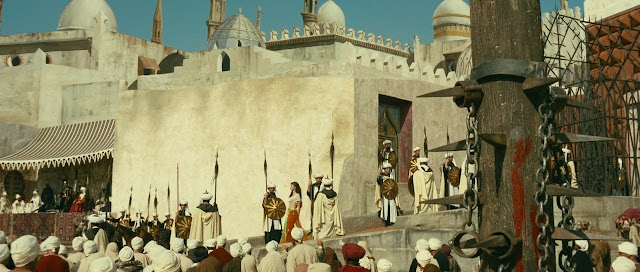 |
| A following shot, made as a slight pan across. The nasty looking spiked post at right conceals Ruiz' rigging supporting his matte extension. |
 |
| Another very spectacular vista courtesy of the immensely talented Emilio Ruiz. Among the 400 odd films he worked on were DUNE, THE INGLORIOUS BASTARDS, RED SONYA, SOLOMON AND SHEBA, EL CID, CLEOPATRA and THE GOLDEN VOYAGE OF SINBAD to name but a handful. |
 |
| Top photo from SHEHERAZADE, while the other two are from CHRISTOPHER COLUMBUS and DESERT OF FIRE, both of which illustrate the methods he employed so successfully since the mid 1940 through to, virtually, the end of his life aged in his eighties. |
 |
| A different view of the city, though the somewhat obtrusive 'post' in the mid frame - holding up the large and weighty matte panel - was a little unfortunate. |
 |
| I'm fairly certain that most readers here will never have heard of this film, with it not being well distributed outside of Europe. |
 |
| Flawlessly rendered ancient city atop a hill as seen from the approach in a key sequence. The big rock is concealing Emilio's support system. |
 |
| The same city on the hill as seen in a reverse angle, just after the shit has literally hit the fan, and the desert is littered with the 'metabolically challenged' (think about it... it's clever!) Note the ever present 'post/obstacle', as well as a fair proportion of dead being matte art too! |
 |
| As a side note, the film had some quite surprising nudity for a 1963 flick - something quite the norm in Europe but would have seen censors reaching for their scissors elsewhere! |
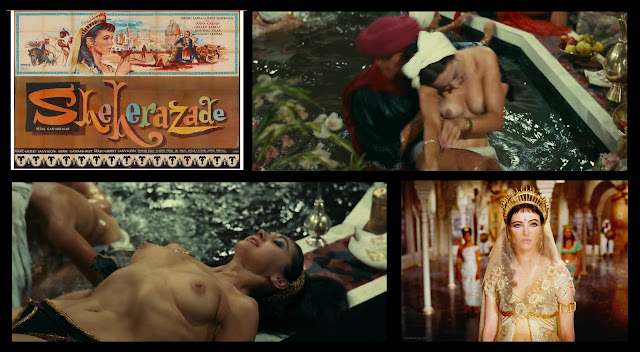 |
| Anna Karina.... need we say more? |
--------------------------------------------------------------------------------------------------------------------------
 |
| MGM's lush, big budget Technicolor remake of the old silent classic, SCARAMOUCHE (1952) was a hit film of the day, thanks in no small part to it's winning casting. |
 |
| The film contains a dozen matte shots, made under the steely eye of Metro's matte department boss, the eccentric Warren Newcombe. This illuminating before and after is a wonderful example of the incredible talent within Newcombe's very secretive matte department. |
 |
| The quite splendid final shot in all its Technicolor greatness. |
 |
| Here we have another rare before and after using one of the standing sets on one of the vast MGM back lots which really were a magical kingdom back in the glory days before it was all eventually bulldozed and sold off to greedy real estate tycoons. |
 |
| The final shot. I love studying the old MGM mattes just to try to spot the often incredibly well integrated matte line. It's visible here, but more often than not, Newcombe's chief matte cameraman, Mark Davis, did wonders in blending things together to perfection, usually with soft splits running through the least likely parts of the shot. |
 |
| One of MGM's matte art specialties were those massive, grand Royal Courts, elegant ballrooms or spectacular opera house interiors. |
 |
| For decades, Newcombe's department had been very active in rendering their mattes using very fine pastel crayons over goache - sometimes with pen and ink fine work. This painting seems to be an entirely 'painted' matte using more commonly applied methods, ie brush and pigments. It's a near full frame matte with just a tiny slot of live action doubled in at the top between two trees. See below... |
 |
| Here we have a fantastic image of that original painting, which is in the collection of a fellow matte shot enthusiast and friend of mine, located in Germany. |
 |
| Close up detail of matted area. I don't know which medium they used here - oils or water based pigment? It has an 'oil' look to it from my observations from afar. |
 |
| More detail in close up... Thanks so much for these pics TT. :) |
 |
| Detail of tower. Based on the two MGM mattes that I own, they were generally quite small in size, and always painted on thick artists' card, which allowed easy drilling out or cutaway gags for certain shots as required such as glittering theatre marquee neons and the like. |
 |
| MGM had the biggest matte department around this time, with a number of artists coming and going over the years. Key matte artists were Howard Fisher and Henry Hillink, with Lou Litchtenfield, Henry Peter McDermott, Irving Block, Norman Dawn and others. |
 |
| The action packed climax takes place in a packed grand opera house during a performance, where our swashbuckling hero, Stewart Granger, pits his rapier against bad guy Mel Ferrer. Several matte paintings are featured showing the setting from various vantage points as they slug it out. Noteworthy here as about half the frame is painted in, with many carefully selected 'slot gags' - that is, tiny cut away holes within the masses of painted people - where a moving interference device behind the painting is illuminated and this 'distraction' lends a sense of 'movement' to the otherwise static, fake audience. An old gag but one in constant use right through to the very end of the so-called 'traditional era' of matting. |
 |
| Live action bottom stalls and first row balcony, with all above being painted in, including the columns, curtains and two other balconies of audience. |
 |
| More of the same sequence. |
---------------------------------------------------------------------------------------------------------------
 |
| Universal Studios picked up several of these Japanese monster shows in the sixties and distributed dubbed versions of them with new American footage spliced in. I was a firm fanatic for Forry Ackerman's great Famous Monsters of Filmland, and took great delight in the generous pictorial coverage of each and every Nippon Monster flick. In fact, I still possess a horde of ancient scrapbooks filled with pics cut out of FM and other similar mags from the early 1970's. |
 |
| KING KONG VS GODZILLA (1963) was one of an endless parade of Japanese-guy-in-a-monster-suit- stomping-on-Tokyo epics that quickly became rather tiresome. |
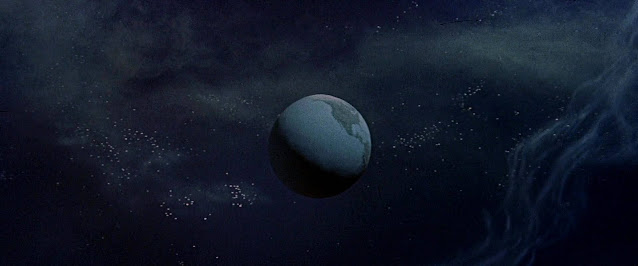 |
| Eiji Tsuburaya was the extremely busy Japanese film industry's go-to guy for anything 'special' or 'trick shot' related. The local industry there, as well as the huge film going public, had enormous admiration for Eiji, who attained something almost of a cult status. |
 |
| A rather nice matte painted shot here. Many of the Japanese sci-fi films had some good matte work, though never credited. Akira Watanabe was usually the visual effects art director on these, so may have had a hand in the matte painting work? |
 |
| The story basically copies the old classic KING KONG, right down to the Skull Island wall and a bunch of misguided natives. |
 |
| Matte painted environs may have influenced Peter Jackson here in NZ for his version of Skull Island? |
 |
| Explorers take to the mountain trail in an almost entirely matte painted shot. |
 |
| I can't recall what the giant squid had to do with the scenario, but here he is with blue screened in natives all getting wayyyyy too close. |
 |
| Didn't I tell you to stand well back from this tentacled bastard. |
 |
| Actually quite effective, done with wire work and puppets. |
 |
| Sunset painted in. |
 |
| Train journey disruption on a monster scale! There will be a temporary disruption to our scheduled service. Sidenote- I was in London once, on the fabulous underground, and not far ahead apparently, a person was actually run over by a train! The punchline was, that in true understated British fashion, an announcement came over the intercom along the lines of "Piccadilly line disruption as a passenger had taken ill". No, I'm not making this up! |
 |
| Selected action set pieces and behind the scenes miniature stage at Toho. Although Eiji already had been involved in cinematography in silent Japanese cinema, and had a thirst for experimentation with things like multiple exposures and basic trick effects, it was a chance viewing in Kyoto of the classic KING KONG in 1933 that firmly left an indelible impression on the young film maker, as it did with so many others in the international movie industry - and rightly so. |
 |
| KONGZILLA - the battle of the Century... or at least till Toho make yet another carbon copy. Note the behind the scenes photo showing the full miniature stage in detail. |
 |
| I always found the monster stuff in these things a tad boring, but always enjoyed the miniature work, with Tsuburaya's model makers being extremely skilled (and highly productive), constantly churning out brand new props, buildings, vehicles, towns and landmarks. |
 |
| One big drawback was shooting these things under artificial light as opposed to natural light, and worst of all, too much zoom lens usage which immediately killed the shot once the depth of field was buggered. |
 |
| The one I remember seeing often as a kid was KING KONG ESCAPES, which always seemed to be showing on one double feature or another at Saturday matinees here in Auckland. Must have seen that one a dozen times, once with ROBINSON CRUSOE ON MARS as I recall. |
 |
| In an interview, Eiji recalled: "When I started to work at Toho, it was 1939. At the time I was the only person in the special techniques department. Not only that, but tricks were considered to be top secret, so I couldn't get any help with special effects. There was no one to depend on but myself. The traditional people in the studio were indifferent toward me. I had to get into the studio secretly". |
 |
| The Japanese made a bunch of rather good science fiction yarns, with things like LATITUDE ZERO being especially good and crying out for a decent BluRay edition. |
.JPG) |
| A selection of behind the scenes snapshots of Toho's special effects team at work on various productions in the 1960's. |
 |
| Most of this view is a matte painted shot. |
 |
| "It wasn't the Mitsubishi Zero's that got him. It was Geisha who killed the beast" |
 |
| Very nice and atmospheric painted Mt Fuji. I went there in 2015. Great country, Japan. |
 |
| Model coastal town in calmer times. One of my favourite Japanese effects films was the out-of-this-world fx heavy epic BATTLE IN OUTER SPACE (1959), which contained so many effects sequences and some bold and wild action set pieces. |
 |
| Fine detail work, though I have a bad feeling about those two duelling giant beasts up on the hilltop! |
 |
| Don't say I didn't warn you... |
 |
| Down-scaling water is one of the most problematic aspects to miniature shoots. |
 |
| The massive torrent washes down the hillside... |
 |
| The village is swallowed up, and once again the insurance pay out for all the wreckage is just enough to meet the budget of the next Japanese 'stomping monster movie'. |
------------------------------------------------------------------------------------------------------------------------
 |
| I've covered a number of these Maria Montez-Jon Hall 'sarong' adventures in other blogs, with this one, WHITE SAVAGE (1943) being pretty much production line run-of-the-mill fare. |
 |
| Strictly minor stuff - manly shark hunter falls for exotic South Sea island princess, with Indian boy sidekick along to balance things out. |
 |
| The stunning Maria Montez made a career at Universal playing the same roles over and over, until her early and sudden death put a halt to her popularity. She was Uni's answer to the far more talented and drop dead sexy Dorothy Lamour over at Paramount, who had far wider range over and beyond the dozen or so 'jungle princess' she starred in. |
 |
| The uncredited special effects were created by one of the industry greats - John P. Fulton. John was a three time Oscar winner for best visual effects, and was responsible for a number of the best effects sequences of all time such as the tiny people in BRIDE OF FRANKENSTEIN, the landmark work in THE INVISIBLE MAN, the parting of the Red Sea in DeMille's THE TEN COMMANDMENTS, the massive effects show THE NAKED JUNGLE and one of my all time faves, the remarkable transformation in SON OF DRACULA where someone turns to wisps of smoke and permeates the bars of a jail cell (much better than it sounds)!! |
 |
| The film has a handful of matte shots by Russell Lawson and an earthquake sequence at the climax. This shot is of course extensively painted, with the live action probably shot at the studio lake at Universal. |
 |
| More Lawson matte work. I've discussed Russ before, but as a refresher, after a short stint at Columbia and Fox, he was Universal's matte painter for several decades, from the 1930's through to around 1962 or so where Al Whitlock took over the department. |
 |
| The third of the three Lawson matte shots. Ross Hoffman would have photographed and composited these, as Universal's very long serving fx cinematographer from around 1930 and all the way through to the mid 70's Whitlock era. |
 |
| For the earth shaking climax, John Fulton supervised the miniature destruction and did a fine job at that. John had a bad reputation unfortunately for being extremely difficult to work with (The late Bill Taylor once told me that he'd never met anyone who had a good word to say for Fulton, which he found so sad as the guy was a huge talent). |
 |
| Fulton was, however, multi-talented. He was skilled with miniatures, optical composite cinematography and pyrotechnics. |
 |
| Shooting models outside in actual daylight was always a good decision, and John did just that, with the results paying dividends when cut into the finished picture. |
 |
| Charlie Baker was Fulton's miniatures expert, and he also held a long career in the field at Universal, again, right through to the late 1970's. Apparently, Charlie was one of the few personnel who got along with Fulton without confrontation. |
 |
| The miniature must have been quite a decent scale, as the demolition looked great. |
 |
| Fred Knoth was a key veteran mechanical effects man at Universal for a long time as well, so may have had a hand in this. Fred had been with Hal Roach Studios for years, working on things like ONE MILLION B.C and many Laurel and Hardy pictures before coming to Universal in 1942 where he remained for decades, working big shows like LAND UNKNOWN and John Wayne's very spectacular oil well firefighter actioner THE HELLFIGHTERS. |
 |
| John Fulton left Universal for Samuel Goldwyn Pictures around 1944, with John's long time optical fx assistant David Stanley Horsley assuming control. Fulton only stayed on a couple of years with Goldwyn then took up a headship over at Paramount. John died quite suddenly in the mid 1960's while beginning miniature effects design for THE BATTLE OF BRITAIN - a dream project os his. |
-------------------------------------------------------------------------------------------------------------
***This post, and all 179 previous blog posts known as 'Matte Shot', were originally created by Peter Cook for nzpetesmatteshot, with all content, layout and text originally published at http://nzpetesmatteshot.blogspot.com/
Well, that's about it for another post...
I hope it was both enjoyable, informative and even a tad irreverent at times. Any comments and feedback is always greatly appreciated.
.jpg)



.JPG)



.jpg)










.jpg)







.jpg)























.jpg)






































.JPG)













.jpg)
.JPG)










.jpg)
.jpg)
.jpg)











.jpg)

.JPG)

.jpg)


.JPG)


























































as always,another winner...i tip my hat to you,good sir.
ReplyDeletegreetings,
William
I'll be so very despondent when the fateful day comes when my number one Dutch matte shot fx fan doesn't leave me a kind note.
DeleteThank you William, and all the best to you my friend,
Pete
Curse you! A handful more titles for the "must get/must watch" list!
ReplyDeleteDavid,
DeleteIf I had a dollar (or a krona) for every time someone 'cursed me', I'd be a rich man, and could buy more great matte art! ;)
Pete
I'm really happy to see John Brosnan's book "Movie Magic" mentioned here. I've owned a copy since the mid 1970s. It's one of the few books I've vowed never to throw out or sell because it was such a source of inspiration to me in the days before Star Wars made "special effects" a household word. Thank you as always for all your hard work and opening our eyes to the hard work of so many special effects technicians and artists.
ReplyDeleteHi 'Anonymous Correspondent' ... (sounds like the title of an un-produced Hitchcock sequel?)
DeleteI'm absolutely with you on the Brosnan book! Bought one in the mid 70's in hardcover - nearly read the thing to death. Also bought the later updated edition which covered disaster movies, and had better quality images.
The chapter on Brit Fx Men is pure, 100% gold! Bugger all was ever documented on guys like Warrington, Richardson, Veevers, Howard, Bowie and co, - with first hand face to face interviews too, so Brosnan deserves a 'bow' from effects fans.
The late Gerald Larn who was Shepperton's last staff matte painter, told me how he well remembered and enjoyed Brosnan's day in the department 'chewing the fat on special effects' as he termed it.
One of my most frequently read/dive into books in my library, MOVIE MAGIC.
Pete
Great reading, as always. Thanks Pete!
ReplyDeleteThanks Marlon
DeleteI do wonder if any of you fine film fans got my joke about Japo-Kong and the planes though? :)
Can't help such asides when 'lost' for a sensible caption!
Pete
Brilliant, as usual!
ReplyDeleteMan, that work from "Heartbeeps" is just amazing! So gorgeous!
ReplyDeleteHi Rick,
DeleteOh brother, isn't it just superb! That opener massive AW painting has always blown my mind, as did the tech work in putting that shot together! :)
Regards
Pete
Fantastic as always! Thank you Peter for continuing to bring to light the wonderful art of matte paintings and giving us great joy to your followers.
ReplyDeleteDomingo
Greetings my good friend,
DeleteI always enjoy hearing from you, all the way from Madrid!
You said it perfectly: 'The Wonderful Art Of Matte Paintings' ... no better description for that magical work, and the people who made it happen.
Take care
Peter
I love your efforts! Thank you, Peter.
ReplyDeleteYou are most welcome Glen. Thank you for your support, it is very much appreciated.
DeletePete
Another amazing post Pete, it always blows my mind how Albert and others always knew what values to paint for a scene, great job per your usual! –Jaimie
ReplyDelete